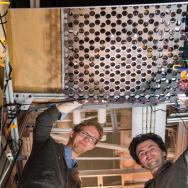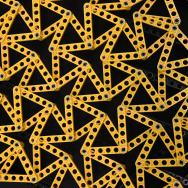A group of University of Chicago scientists are testing the boundaries between machines and materials. Blurring these lines, they claim, could enable new kinds of technology.
“We’re trying to get a sense of what is possible,” said Vincenzo Vitelli, a professor of physics in the James Franck Institute. “If you question the foundations of a subject like elasticity, you are bound to stumble into interesting consequences. The concepts we’ve uncovered could be useful for engineering, biology, and robotics alike.”
Scientists and engineers are always searching for the principles that underlie all the phenomena we see around us. Such principles often form the basis for new technologies—just as the discovery of thermodynamics led to the heat engines that powered the Industrial Revolution. One area of particular interest in this search today is a subject called “active matter,” which describes how matter behaves when it’s made up of constituents powered by tiny little engines. These engines can be synthetic or living components—a classic illustration is the movements of a flock of birds.
“But while there’s been a good amount of investigation into active matter that behaves like a fluid, there has been far less on the rules that govern active matter that behaves as a solid,” said Prof. William Irvine.
The classic way to picture a solid’s makeup is as a cluster of masses connected by springs. In a study published March 2 in Nature Physics, Vitelli, Irvine and collaborators sought to rethink the nature and behavior of solids. They imagined a solid that was instead connected by active springs powered by tiny batteries—taking it from strictly a material into the realm of machines.
A visualization of the imaginary material’s movements (Illustration courtesy Vitelli et al.)
When they examined how a solid made from such springs would respond to pressure—for example, if you squeezed a football—they saw that instead of simply deforming and then bouncing back, the material would rotate.
“The solids we describe can be thought of as elastic engines that use shape to turn internal energy into useful work,” said graduate student Colin Scheibner, who is co-first author on the paper along with Anton Souslov (formerly a postdoctoral researcher at UChicago, now faculty at the University of Bath).
For example, engineers may need a way to convert pressure into rotation in a machine.
“The simplifying principles we discovered enable exploration of new classes of mechanical properties,” added Vitelli.
Engineers could leverage odd elasticity to transmit information through elastic waves in solids that normally resist vibration; or they could even revise the idea of a chemical bond itself. “Currently a chemical bond is thought of as a passive concept, but what if you could make an active chemical bond? This could inspire people who design molecules,” Vitelli said.
“This type of fundamental research reveals opportunities that traditional approaches would have forever kept hidden from us,” said Sam Stanton, program manager, Complex Dynamics & Systems at the Army Research Office.
Other co-authors were Debarghya Banerjee, a postdoctoral researcher with the Max Planck Institute for Dynamics and Self-Organization previously at Leiden University, and Piotr Surówka with the Max Planck Institute for the Physics of Complex Systems.
Citation: “Odd elasticity.” Scheibner and Souslov et al, Nature Physics, March 2, 2020. https://doi.org/10.1038/s41567-020-0795-y
Funding: Army Research Office, National Science Foundation (Chicago MRSEC), Engineering and Physics Science Research Council, Deutsche Forschungsgemeinschaft.











 —Prof. Jacqueline Stewart
—Prof. Jacqueline Stewart
